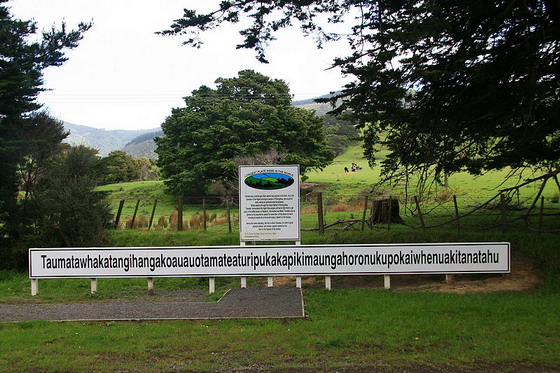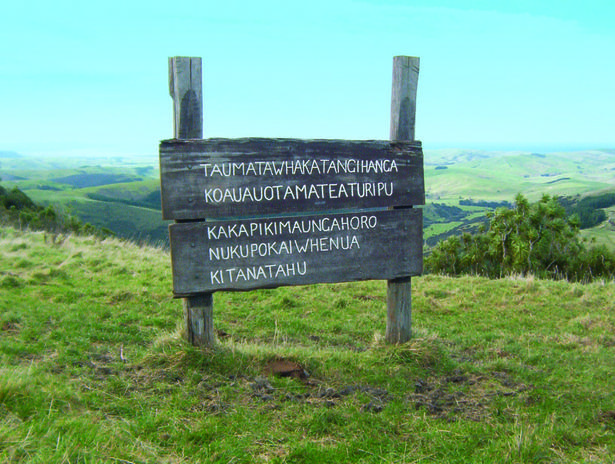Taumatawhakatangihangakoauauotamateaturipukakapikimaungahoronukupokaiwhenuakitanatahu is the M?ori name for a hill, 305 metres (1, 001 ft) high, close to Porangahau, south of Waipukurau in southern Hawke’s Bay, New Zealand.
The name is often shortened to Taumata by the locals for ease of conversation. The New Zealand Geographic Placenames Database, maintained by Land Information New Zealand (LINZ), records the name as “Taumatawhakatangihangakoauauotamateapokaiwhenuakitanatahu”. It has gained a measure of fame as it is the longest place-name found in any English-speaking country, and it is the second longest place-name in the world, according to Wises New Zealand Guide and reported in the New Zealand Herald.
Meaning
The name on the sign that marks the hill is “Taumatawhakatangihangakoauauotamateaturipukakapikimaungahoronukupokaiwhenuakitanatahu”, which translates roughly as “The summit where Tamatea, the man with the big knees, the climber of mountains, the land-swallower who travelled about, played his nose flute to his loved one”. At 85 letters, it has been listed in the Guinness World Records as one of the longest place names in the world.
Oher versions
Other forms of the name are longer still: “Taumatawhakatangihangakoauauotamateaurehaeaturipukakapikimaungahoronukupokaiwhenuakitanatahu” has 92 letters. An even longer version, Taumata-whakatangihanga-koauau-o-Tamatea-haumai-tawhiti-ure-haea-turi-pukaka-piki-maunga-horo-nuku-pokai-whenua-ki-tana-tahu, has 105 letters and means The hill of the flute playing by Tamatea — who was blown hither from afar, had a slit penis, grazed his knees climbing mountains, fell on the earth, and encircled the land — to his beloved.
Tamatea, explorer of the land
Tamatea-p?kai-whenua (Tamatea the explorer of the land) was the father of Kahungunu, ancestor of the Ng?ti Kahungunu iwi. Mention of Tamatea’s explorations of the land occur not only in Ng?ti Kahungunu legends, but also in the traditions of iwi from Northland, where he is said to have explored the Hokianga and Kaipara harbours. In traditions from the Bay of Plenty region, he left a son, Ranginui, who is the ancestor of Ng?ti Ranginui of Tauranga. Legends from the East Coast of the North Island tell of his explorations in T?ranga-nui (Gisborne), M?hia, Wairoa, Ahuriri (Napier), Heretaunga (near Hastings) and P?rangahau. He travelled via the Mangakopikopiko River, over the T?t?-o-kura saddle via Pohokura to Lake Taupo. The ?tamatea River and swamp is named after him. Tamatea is also the name of a place in Napier. Early South Island legends say that Tamatea sailed down the east coast. His canoe was wrecked in the far south, and transformed into T?kitimu mountain range. Tamatea then returned to the North Island, and travelled via the Whanganui River.
In popular culture
The name is featured in a Mountain Dew jingle, and it also appears in the 1979 single “Lone Ranger” by British band Quantum Jump. Kenny Everett used a padded out version of the name as the introduction to the weekly aired “Kenny Everett Video Show” featuring an animated cartoon native speaking the words. It is the subject of a 1960 song by the New Zealand balladeer Peter Cape.
Czech group Mako!Mako playing Run’n’Be style composed a song Taumata where the full name is the only word used in lyrics. Tennis star Martina Navratilova learned to say the word when she was ten years old.
Source: Wikipedia

